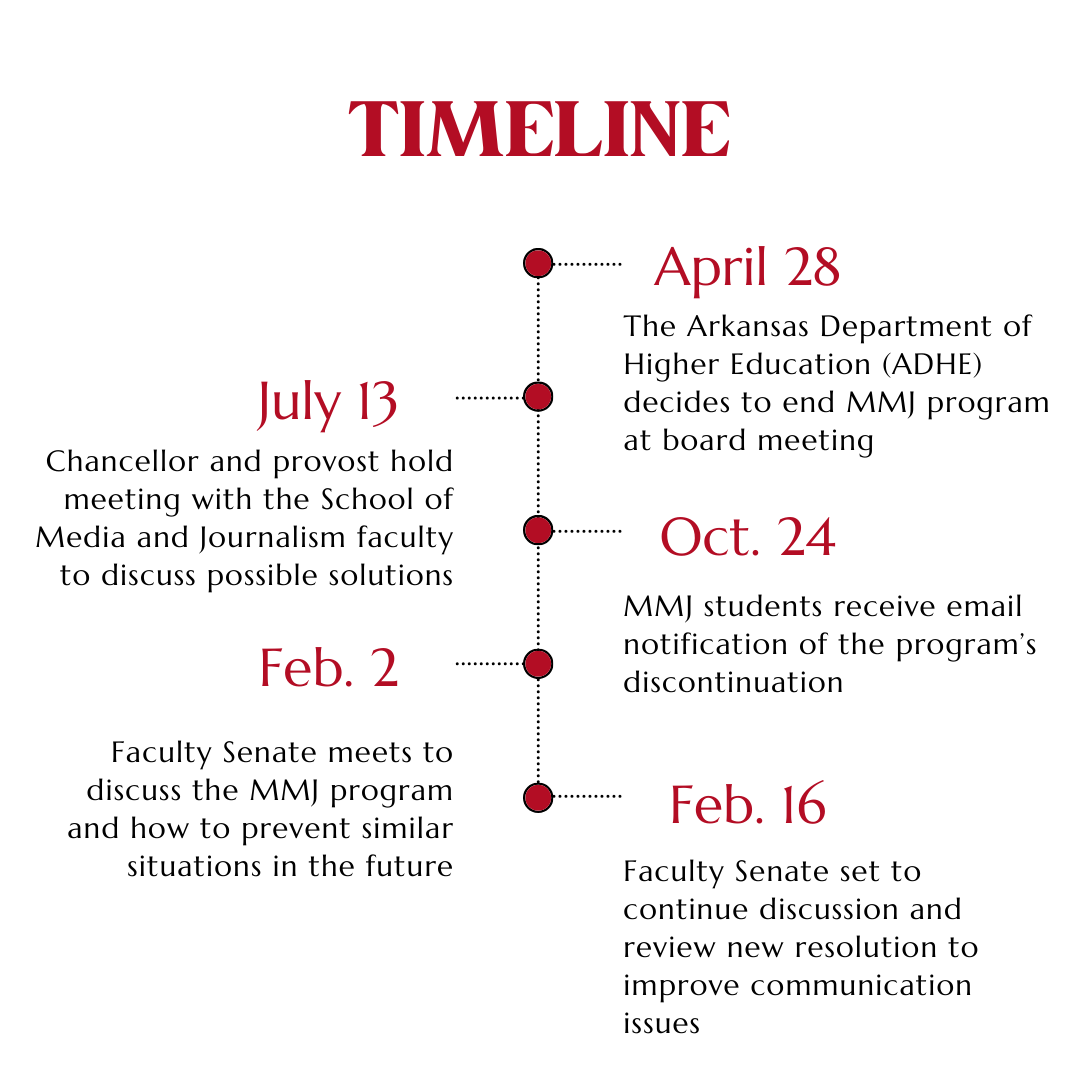An update on the discontinuation of multimedia journalism at A-State
Note: Article originally published on Wed., Feb. 7 in The Herald.
Thursday, Feb. 8, 2024
By A-State Herald | Contributor
JONESBORO, Ark. – Faculty Senate met with Chancellor Todd Shields, Ph.D., and other faculty to discuss the deletion of the bachelor of science in multimedia journalism (MMJ) degree and how to prevent similar situations in the future.
“I will not be here and not have a journalism program,” Shields said.
“I will not be here and not have a journalism program,” Shields said.
Todd Shields, Arkansas State University Chancellor
The Arkansas Department of Higher Education (ADHE) decided to discontinue the MMJ program at an April 28 meeting. Interim Dean of the College of Liberal Arts and Communication Brad Rawlins, Ph.D., sent an email to students informing them about the decision Oct. 24.
Gary Edwards, Ph.D., associate professor of history, prepared a document regarding the circumstances of the discontinuation of the MMJ program to be reviewed during the meeting last Friday.
“We failed multimedia journalism,” Edwards said.
“We failed multimedia journalism,” Edwards said.
Gary Edwards, Ph.D, Associate Professor of History
Those in attendance discussed what led to the end of the MMJ program, including ADHE policy, communication issues, internal strife between MMJ and creative media production (CMP) faculty and curriculum issues.
ADHE POLICY
According to Arkansas Higher Education Coordinating Board (AHECB) policy, a bachelor’s degree program must have an average of six graduates per year for three years to meet viability standards. Otherwise, the program will be cut. Only 4.3 MMJ students graduated during the review period.
Shields said he prepared to defend the MMJ program to the AHECB, but the board would not hear arguments.
“I went ‘What the hell was that?’ That had never happened since I’ve been doing that since 1994,” Shields said.
COMMUNICATION ISSUES
In addition to declining numbers, Rawlins, who formerly served as the director of the School of Media and Journalism, said the MMJ department was not properly informed about the possible cut of the program. He said if the department had been made aware, they would have addressed the issue much quicker and more vigorously.
“I’ve done a deep search with all my emails and talked to people, it’s just not there,” Rawlins said.
“I’ve done a deep search with all my emails and talked to people, it’s just not there,” Rawlins said.
Brad Rawlins, Interim Dean of the College of Liberal Arts
Shields said he does not know why the department was not notified. He said communication should be improved, but each department should monitor its own enrollment and address issues before the ADHE notifies them.
“ADHE is no longer the one we talk to,” Shields said. “They’re the ones that dictate to us.”
INTERNAL STRIFE
The chancellor and provost, Calvin White, Ph.D., met with MMJ and CMP faculty July 13 and proposed the two programs combine to keep journalism at A-State. Shields said he hoped the programs would be revised over the fall semester.
“That did not happen. In fact, I was told ‘We’re not working together,’” Shields said,
After that meeting, Mary Jackson-Pitts, Ph.D., program coordinator of CMP, sent an email to Gina Hogue, Ph.D., interim director of the School of Media and Journalism saying, “We are not willing to reimagine or launch a new journalism curriculum with the existing MMJ faculty. We have a proposal to establish a broadcast journalism emphasis under the creative media production program.”
“We are not willing to reimagine or launch a new journalism curriculum with the existing MMJ faculty. We have a proposal to establish a broadcast journalism emphasis under the creative media production program.”
Mary Jackson-Pitts, Creative Media Program Coordinator
The cause of the issues between the departments was not discussed at the senate meeting.
“I don’t know the history,” Shields said. “I don’t necessarily want to relive all that, whatever it is. I kind of don’t care. It’s ‘Do you want to work together and have jobs or do you not?’ Do you pull together for the benefit of the students and the campus, or do you not?”
Shields said he still hopes the MMJ and CMP faculty will work things out and revise the programs to be combined.
“It surprises me, in fact almost maybe hurts me in a way that is hard to describe. That’s not the A-State that I’ve seen anyplace else,” Shields said. “If people are being uncollegial to the point of hurting students in the program, that has to be dealt with.”
Shields said if the MMJ and CMP programs cannot work together, he will consider removing the program from faculty control and giving control to someone with experience in revising programs.
CURRICULUM ISSUES
Pitts, a professor of creative media production, formerly taught journalism for 27 years. She said she finds issues with the current curriculum MMJ teaches.
She said the curriculum focuses on writing, but students need to learn other skills such as coding, web design and audio and video production.
“To prepare that student to only work in print journalism is not fair,” Pitts said. “It is imperative that we look to what happens in the future for journalism and the best way to prepare them. It is not just about writing, it is about all the ways that you guys consume news now and how you will consume it in the next few years.”
According to the MMJ description on the A-State website, the program prepares students to work in broadcast, digital, print and photojournalism.
“Through hands-on instruction, practical workplace experience and conceptual coursework, students learn how to create and distribute content for print, radio, television, digital, interactive, social and mobile media,” the description read.
Sandra Combs, associate professor of multimedia journalism and adviser to The Herald, said in the meeting she does not expect any reconciliation between the departments.
“The four of us in MMJ have been working since summer of 2023 to come up with a minor for MMJ, to come up with core curriculum ideas for MMJ. Aside from that, we are met with opposition that has been in writing from those who do not support journalism because it’s not creative,” Combs said.
“The four of us in MMJ have been working since summer of 2023 to come up with a minor for MMJ, to come up with core curriculum ideas for MMJ. Aside from that, we are met with opposition that has been in writing from those who do not support journalism because it’s not creative,”
Sandra Combs, Associate Professor of Multimedia Journalism
The CMP program coordinator said journalists should have skills in audio and video production to succeed in the industry today. She said the current MMJ curriculum does not meet these standards.
Lillie Fears, Ph.D., MMJ program coordinator, said she thinks the MMJ curriculum provides students with multimedia skills, especially in classes such as multimedia reporting and digital media production.
She said the MMJ program previously taught broadcast journalism but has not offered any courses since the previous instructor, Larz Roberts, left A-State.
Roberts left after the 2021/2022 academic year to teach at the University of Mississippi, with the position unfilled since his departure.
“The year that Larz Roberts left, I was in a position to hire an adjunct faculty that teaches in those broadcast journalism areas. I went to every journalism class and tried to recruit students to register for those classes and the enrollment was so low that I could not justify hiring an adjunct faculty member to teach those classes,” Rawlins said.
Rawlins said he is unsure if the position will be filled in the future, due to uncertainty with the curriculum.
“It would be a position that would teach both in creative media production and in journalism. But in order to make that position work, it needed to have a curriculum that matched the needs of that particular position”
EFFECTS ON OTHER PROGRAMS
William McLean, senior vice provost for academic affairs, said emphasizing how good a program is for the community does not work when defending low viability programs to the AHECB. He said the AHECB is not interested in why a program cannot reach viability standards, they only look at the numbers.
Pitts said the Faculty Senate should ask for transparency from the administration regarding program viability and specific data required to stay viable.
“If we are not, as faculty, supplied with the exact number that is being submitted to somewhere at ADHE related to graduation numbers, then everybody will be surprised when it happens to any of your programs,” Pitts said.
Pitts said there are inconsistencies regarding the data available to her and the data used to determine program viability.
Faculty Senate president Ed Salo said communication was lost somewhere along the way. He said he wanted faculty to write a resolution to ensure “the ball doesn’t get dropped again.”
Associate professor of chemistry John Hershberger, associate professor of English Khem Aryal and Edwards volunteered to write the resolution that will be presented at the next Faculty Senate meeting, Feb. 16.
This story will be updated as more information becomes available.
-30-
NOTE: Feature image shows a timeline of the MMJ program deletion process at A-State. (Graphic by Caroline Averitt | The Herald Life Editor)
Read more:
‘I will not be here and not have a journalism program at A-State’!. Article may or may not reflect the views of KLEK 102.5 FM or The Voice of Arkansas Minority Advocacy Council





Comments